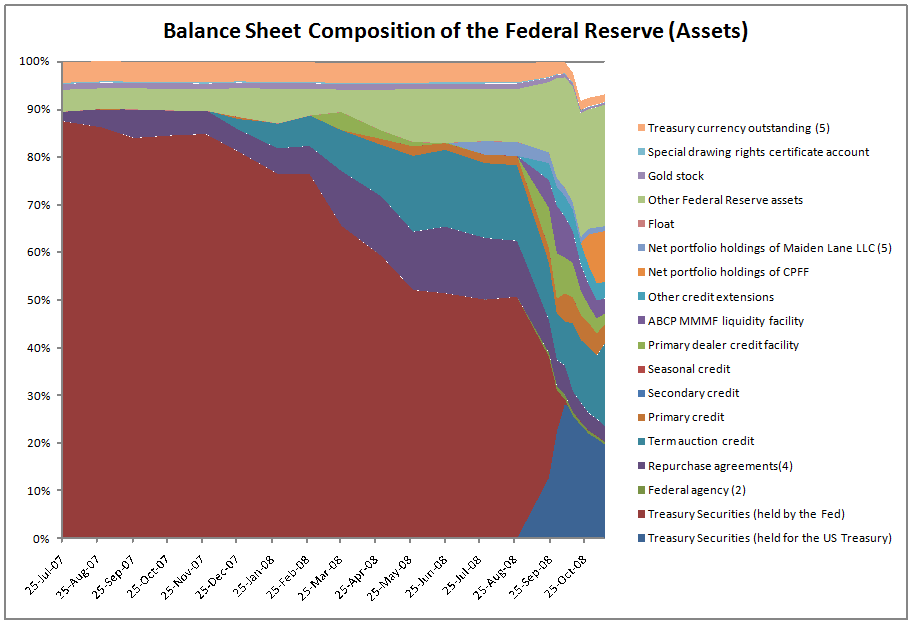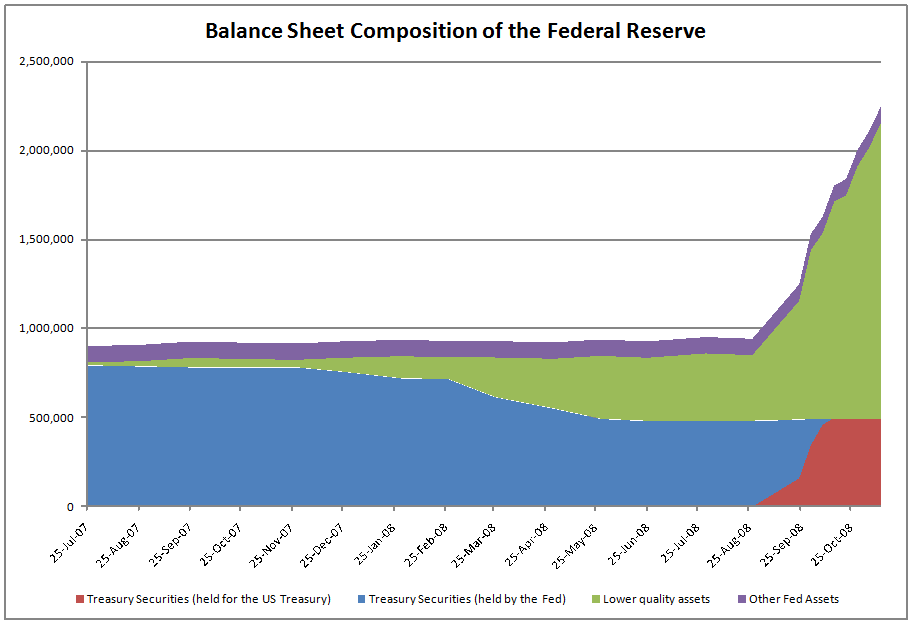(Alternate Title: Be a Bank; Or, Just Look Like One.)
There has been a significant shift in bailout psychology over the last week or two.? The grand shift has been to make the cost of receiving money from the US government smaller, which gets “banks” to line up for cheap money, and non-banks like CIT and American Express to become banks.? Insurers with Thrift arms can be “banks” as well.? The hurdle for help is low.
This is the wrong philosophy.? Bailouts have to be the best of a bunch of bad solutions, rather than something financial companies like.? Common and Preferred Equity need to get whacked hard, and subordinated debt needs to take a haircut.
The present situation has the Treasury coming back to Congress for the second $350 billion quite rapidly, with little accountability for what they have done already.? How can we tell that what the Treasury has done is right?? How can we tell that it is fair?? Answer: we can’t.
In giving and forcing money into healthy institutions, the Treasury has wasted money, in my opinion.? Far better to give it to marginal institutions that need a little to get by in exchange for a large stake in the institution.? But what they have done so far resembles giving aid to the largest politically connected firms, whether they need it or not.
Going back to Walter Bagehot, Central Banks should lend without limit at a penalty rate during a crisis.? That rate should hurt, but it is better than no access to credit.? To do otherwise is to shortchange taxpayers, and place the value of the Dollar at risk.? That is what we are doing now.
Consider these graphs:
http:/www/alephblog.com/wp-content/uploads/2008/11/
Or, the oversimplified version:
The Federal Reserve was once a simple institution. Bloated with too many people for the task at hand, but simple all the same.? But now, the Fed no longer controls its destiny.? What high-quality securities that Fed holds belong to the US Treasury.? And, if you look at the top graph, you will see a gap in the Northeast corner.? That represents the degree that the Fed is short high quality Treasury assets.? Not pretty.? In a real crisis, where the Fed would face a call on cash, the result would either be inflation or severe recession.
Our government is rhyming with what it did during the Great Depression; they aren’t finding ways to reduce overall debt levels.? They are moving deck chairs around on the Titanic.? Our economy will not be healthy until we reduce debt relative to GDP.? That’s not on the agenda now, which means we might imitate Japan for the next few decades, assuming our entitlements crisis doesn’t do us in.
Links:


The bailout packages to date have clearly been badly designed, and I give credit to you and other critics for pointing out some of the problems and wrongheadedness in advance – though overall I’ve grown more and more concerned in this ongoing crisis that supposed experts seem completely clueless and at odds with one another about what to do so it would just be dumb luck is typically clueless politicians voted for the right thing.
That said, whatever course of action is adopted, there are a lot of competing concerns that are in conflict, so whatever is done or not done will be bad on some counts. Here’s an incomplete list:
1) Cascading writedowns/defaults – the idea that failure of any institution causes a large markdown event for other institutions leading to further distressedp selling of assets and defaults – this seems to be the idea about why the Lehman failure had so many negative ramifications
2) Market failure of lending to non-financials – the idea that good risk borrowers are unable to get credit at reasonable rates, starving the economy and creating a further downward spiral
3) Failure of inter-bank lending – the idea that banks are not lending to each other at viable rates due to suspicions about insolvency of other financial institutions or internal short term liquidity emergencies
4) Generic Keynesian type problems in the economy – the idea that consumers and business are pulling back on spending too fast for the health and efficiency of the economy (I think of a Keynesian as basically someone who believes there is an emergent long term inefficiency caused by these sharply above or below trend short term expansion/contraction phenomena)
5) Mortgage/Housing specific problems – including the ideas that foreclosures are so inefficient that it is important to prevent them and that rate of home sales is a crucial macro variable with a high multiplier
6) Worries about the U.S. Federal debt and commitments
7) Worries about the financial health of municipal govts.
8) Worries about the value of the U.S. dollar and future inflation.
9) Worries about the moral hazard effect of bailouts
10) Worries about the fairness of favoring particular institutions and investors over others.
11) Worries about fairness to the U.S. taxpayer
12) Worries about the inefficiency of giving aid to badly run corporations.
Now, with respect the above list, one can talk somewhat simplistically about comparative benefits and harm of five policies at the margin: buying distressed assets from weak banks, buying distressed assets from strong banks, buying equity in weak banks, buying equity in strong banks, and doing nothing. I won’t take the time/space to go through the complete matrix, but here are a few points of rebuttal to the point of the piece above that it is better to help the weak banks: a) any bailout of a small bank is almost pure waste if the bank is still headed for insolvency shortly afterwards anyway, it is not helpful to issues 2), 4), and 5) if the result is a bank that only avoids insolvency by shutting down most lending, it is not helpful to 3) unless the cloud of worry is removed after the intervention, and it goes against issues 9) and 12). The counter argument is presumably that the better course is to inject enough equity into each weak bank to clearly make it a strong bank that has no incentive to hoard cash. But is it possible and practical to do that on a systemic basis?
I’ve read over and over about how Bernanke studied the Great Depression in detail and figured out how to avoid it. But if the key strategy depended on avoid a deflationary environment before it got started, perhaps it is already too late for that plan. In particular, conventional financial stimulus through financial entities probably doesn’t work well in an environment where cash is outperforming other investment/lending choices. Selling a lot of treasuries and then buying them back (or issuing them back) later at a cheaper price is a rather sensible strategy in such an environment (though exchanging them for worthless crap is not).
I agree that we’ve been doing it wrong! I don’t think Obama will be any worse – but I don’t think he’ll be any better – He will continue to take the government down the same road, which is bad – Bail Outs, Stimulus packages, interest rate changes, printing money like it’s water, etc, etc. Go look at most of his advisers – they come from Goldman Sachs, the Federal Reserve, Freddie Mack, etc, etc. Last time I checked, he was in favour of the first bail-out despite all it’s faults. The fact that he is a lawyer and can understand the legalities of the fine print and stil gave it a thumbs up, scares me.
Truth is, it isn’t government’s job to create jobs, and by picking winners and handing out money, they are just trying to cheat economics – economics will win in the end despite government actions. So, IMHO, the government (despite what party is in power) has been going the wrong direction for a while.
The government (both Democrat and Republican) has been trying to get the consumer to take on more debts for a long time to give the illusion the economy is fine and dandy. An economy financed on debt will ultimately fail; It is unsustainable. Every time there is a hicup in the economy – they lower interest rates to entice consumers to take on more debt – which serves only to MASK the underlying problem with the economy – competitiveness. When lowered interest rates fail, the bail-outs and stimulus packages start to pop into the political agenda. None of these deal with the underlying situation – COMPETITIVENESS and Sustainability.
“In giving and forcing money into healthy institutions, the Treasury has wasted money, in my opinion. Far better to give it to marginal institutions that need a little to get by in exchange for a large stake in the institution. But what they have done so far resembles giving aid to the largest politically connected firms, whether they need it or not.”
But wasn’t the point to create a little deliberate ambiguity, so accepting a capital infusion wasn’t seen as a sign of weakness?